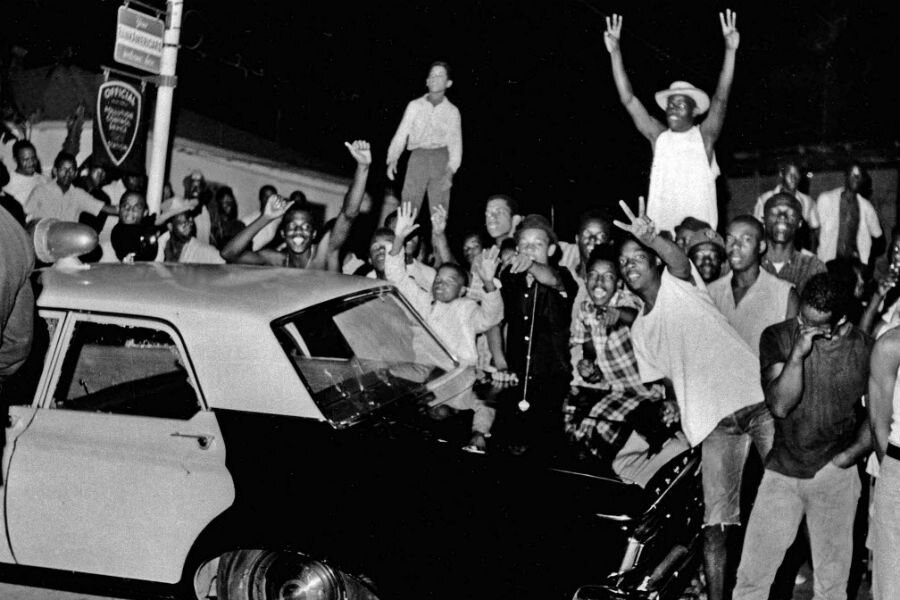What could Ferguson learn from Watts, 50 years later?
Loading...
On August 11, 1965, two white policemen pulled over Marquette Frye, a black motorist whom they suspected of drunk driving, in Los Angeles’ Watts neighborhood. A roadside argument escalated into a physical struggle, attracting the attention of angry bystanders and inciting a five-day riot against police discrimination that resulted in 34 deaths and more than 1,000 injuries.
Today, 50 years after the Watts riots, a glance at the state of police relations in predominantly black communities across the country would suggest that not much has changed. The deaths of black men while being detained by white police officers has led to protests – sometimes violent – in Baltimore, New York, and Ferguson, Mo., and inspired the national Black Lives Matter movement.
According to a June 2015 Gallup poll, Americans’ confidence in the police today is the lowest it has been in 22 years, and an all-time low of 18 percent of citizens report having little to no confidence in the police.
But while mistrust of law enforcement has risen in the rest of the country, the reverse is slowly occurring in Watts, offering possible lessons on how to improve police-community relations in other cities.
"The relationship back then, it was hostile. There was mutual disrespect. There was mutual fear," said Capt. Phillip Tingirides, who leads the Los Angeles Police Department’s community station in Watts, to CBS News. "We were so busy going from one shooting scene to the next … and just not even looking at this community as being families, as being people who are suffering.”
Today, community leaders say the neighborhood’s relationship with the police is the best it’s ever been, and violent crime rates have seen a dramatic decrease in recent years. In 2005, 20 homicides occurred in Watts. There have been two so far in 2015.
Donny Joubert, a former gang member turned community activist, attributes this shift largely to Watts’ new Community Safety Partnership, a pilot program engineered by the LAPD and the city’s Housing Authority.
Through the program, 10 LAPD officers and one sergeant are assigned to each of the three housing projects that used to account for much of the crime in Watts. The officers patrol the area by foot, but also serve as mentors for the children living there by coaching youth football and track teams, organizing field trips, and assisting with schoolwork.
“They don’t think the kid is out to kill them; they’re not out to kill the kid,” said Mr. Joubert to The New York Times. “They walk and they know who they are talking to.”
One of the changes that’s led to these improvements is a newfound willingness by the police to work with community leaders, says neighborhood resident Dr. Perry Crouch. For nearly a decade, a Watts Gang Task Force made up of Joubert and other concerned citizens has met once a week to exchange information with the police and work out ways to reduce gang tensions in the community.
"We got them to see us as a partner," Dr. Crouch, who worked to broker a peace treaty between rival gangs and led efforts to get guns out of Watts, told NPR. "And they got to seeing us doing certain things to make their job easier.”
Despite these improvements, Watts is by no means a utopia of racial harmony. Officers still face mistrust from some young men in the community, and there is no telling if another riot could be set off by an act of police brutality, either locally or across the country. But community leaders and officers agree that another riot on the same scale as 1965's is unlikely.
“There’s always a sense things can boil over,” said Nina Revoyr of the Children’s Institute in Watts to the Times. “But there’s a sense of maturity here; the neighborhood has been through all this before and the transformation has happened. There’s a true relationship — you see a problem, and you talk about it.”






